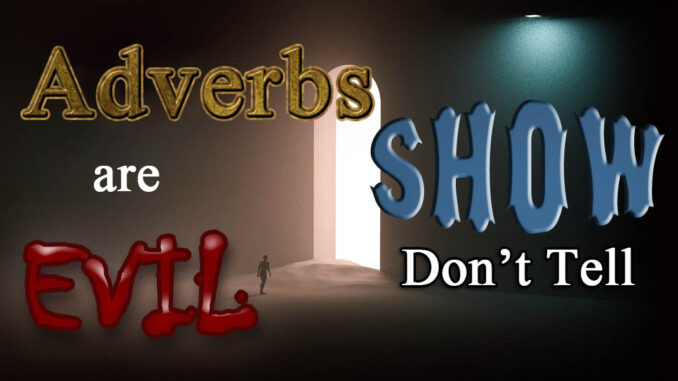
Adverbs are Evil – Show Don’t Tell
While working on my latest WIP (Work In Progress) I caught myself over using adverbs. I mentally slapped my hand, tapped the backspace button and took a deep breath. I learned a long time ago that adverbs were evil and you should limit your use of them in writing – more so, you should try to avoid them altogether… but why? The answer is; Adverbs are Evil – Show Don’t Tell. Let me explain.
What is an Adverb?
An adverb is a word that modifies a verb. A quick way to spot an adverb is if your words before or after the verb (the action word) end in LY.
He ran quickly through the door.
Now the above sentence seems fine, right? It TELLS the reader exactly what is happening. But what if you removed the adverb?
He ran through the door.
Same sentence. One less word. Same exact scenario. In fact, the verb ran imbues the definition of quick. You can technically run quick, but if you are running, you are still traveling quicker than if you were walking.
That is an example of an unnecessary adverb. It doesn’t help the story and sometimes even slows it down. On top of that, when you find you CAN take away an adverb and the sentence still reads fine, you are also doing the second no-no in writing, Telling the Story rather than showing it. This is why the word TELLS is capitalized and bold.
What is “Show Don’t Tell”?
You will hear that a lot in writers forums and groups, but what does it mean? The above sentence is telling the reader what is happening, there is no interpretation for the reader.
Isn’t that a good thing you are wondering? You might say so, but have you ever heard someone say the book was better than the movie? It is because when you are reading a book, a well-written book, your mind gets to interpret the scene, to imagine what is happening, make your own movie in your head. Nothing that you can watch will likely ever be better than the movie you imagined, because it is yours.
This is why description is so important in writing. Describing the scene is not just detailing where the furniture is and what color the drapes are. Describing the scene also shows the reader what the characters are doing. Take the above sentence and read it with a bit of “show” description.
With only four seconds remaining on the digital display, his adrenaline surged. He dug his toes into the concrete floor and bolted through the door seconds before the blast.
As you can see, he was definitely quick as he ran through the door, but you now know why. Most importantly, you may have felt his adrenaline, imagined the scene, and possibly even saw the explosion in your head as he escaped the building. That is what Show Don’t Tell offers the reader. By locating the adverbs (do a quick find in Word for LY words) and then acknowledging that those sentences may be telling and not showing, you can rewrite the scenes to express more emotion and show the reader ways to imagine a great story with you.
Emotional Adverbs in Dialogue
There is more to those pesky adverbs than amplifying action verbs. They’re also overused when dealing with emotion.
“Where did my car go?” he asked angrily.
Just like before, you can easily remove the adverb, angrily, and have a proper dialogue question, but you lose the emotion.
“Where did my car go?” he asked.
To add the emotion back without using an adverb, you need to show the reader what the character is thinking or feeling.
“Where did my car go?” he growled with fire in his eyes.
Take-aways
- Utilizing Word’s Find feature, type in the letters LY. It will show you each result and if the result is an adverb, write the word out of the scene.
This is just a small sampling of adverb use and how to eliminate them. If you want to learn more check out the post: Over-Use of the word ‘Said’
